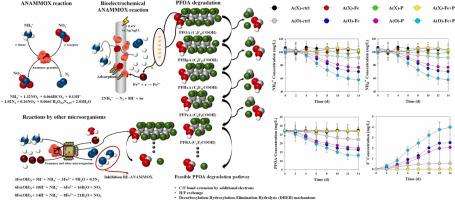当前位置:
X-MOL 学术
›
Process Saf. Environ. Prot.
›
论文详情
Our official English website, www.x-mol.net, welcomes your feedback! (Note: you will need to create a separate account there.)
Application of electric potential and Fe(Ⅲ) to stimulate perfluorooctanoic acid (PFOA) degradation using mixed culture anammox granules
Process Safety and Environmental Protection ( IF 7.8 ) Pub Date : 2024-04-16 , DOI: 10.1016/j.psep.2024.04.081 Jonghwa Lee , Sangyeol Jo , Kadam Rahul , Beom Lee , Taeyoung Kim , Jungyu Park
Process Safety and Environmental Protection ( IF 7.8 ) Pub Date : 2024-04-16 , DOI: 10.1016/j.psep.2024.04.081 Jonghwa Lee , Sangyeol Jo , Kadam Rahul , Beom Lee , Taeyoung Kim , Jungyu Park

|
Pollution by perfluorooctanoic acid (PFOA), a highly persistent and toxic substance, is commonly addressed with several approaches, but the need for post-treatment affects their environmental and economic sustainability. Biodegradation, which can efficiently degrade micropollutants in water under optimal conditions, offers a promising solution, but faces challenges from the persistence of the C-F bond and the high reactivity of F. Despite recent use of various microorganisms for PFOA degradation, performance issues persist. In this study, we aimed to simulate PFOA degradation while mixed culture anammox granules oxidize NH and to confirm the effects of electric potential and Fe(Ⅲ) applications on PFOA degradation. A control reactor containing only anammox granules exhibited NH and PFOA removal efficiencies of 11.52% and 19.2%, respectively, with traceable biodegradation at 3.7%. In contrast, a reactor that applied both electric potential and Fe(Ⅲ) demonstrated enhanced removal efficiencies of 41.98% and 50.93%, with traceable biodegradation at 35.03%. Bio-electrochemical properties also improved, showing an average current generation of 331.95 μA and Coulombic efficiency of 141.79 ± 7.6%. This study shows that mixed-culture anammox granules with electric potential and Fe(Ⅲ) can be introduced for efficient PFOA biodegradation and provides the basis for further studies on overcoming the limitations of PFOA biodegradation.
中文翻译:

应用电位和 Fe(Ⅲ) 刺激混合培养厌氧氨氧化颗粒降解全氟辛酸 (PFOA)
全氟辛酸 (PFOA) 是一种高度持久性和有毒的物质,通常通过多种方法来解决,但后处理的需要会影响其环境和经济的可持续性。生物降解可以在最佳条件下有效降解水中的微污染物,提供了一种有前景的解决方案,但面临着CF键的持久性和F的高反应性的挑战。尽管最近使用各种微生物来降解PFOA,但性能问题仍然存在。在本研究中,我们旨在模拟混合培养厌氧氨氧化颗粒氧化NH时的PFOA降解,并确认电位和Fe(Ⅲ)应用对PFOA降解的影响。仅含有厌氧氨氧化颗粒的对照反应器的 NH 和 PFOA 去除效率分别为 11.52% 和 19.2%,可追踪生物降解率为 3.7%。相比之下,同时施加电势和 Fe(Ⅲ) 的反应器的去除效率分别提高了 41.98% 和 50.93%,可追踪生物降解率为 35.03%。生物电化学性能也得到改善,平均产生电流为 331.95 μA,库仑效率为 141.79 ± 7.6%。本研究表明,引入带电位的厌氧氨氧化颗粒与Fe(Ⅲ)混合培养可实现PFOA的高效生物降解,为进一步研究克服PFOA生物降解的局限性提供了基础。
更新日期:2024-04-16
中文翻译:

应用电位和 Fe(Ⅲ) 刺激混合培养厌氧氨氧化颗粒降解全氟辛酸 (PFOA)
全氟辛酸 (PFOA) 是一种高度持久性和有毒的物质,通常通过多种方法来解决,但后处理的需要会影响其环境和经济的可持续性。生物降解可以在最佳条件下有效降解水中的微污染物,提供了一种有前景的解决方案,但面临着CF键的持久性和F的高反应性的挑战。尽管最近使用各种微生物来降解PFOA,但性能问题仍然存在。在本研究中,我们旨在模拟混合培养厌氧氨氧化颗粒氧化NH时的PFOA降解,并确认电位和Fe(Ⅲ)应用对PFOA降解的影响。仅含有厌氧氨氧化颗粒的对照反应器的 NH 和 PFOA 去除效率分别为 11.52% 和 19.2%,可追踪生物降解率为 3.7%。相比之下,同时施加电势和 Fe(Ⅲ) 的反应器的去除效率分别提高了 41.98% 和 50.93%,可追踪生物降解率为 35.03%。生物电化学性能也得到改善,平均产生电流为 331.95 μA,库仑效率为 141.79 ± 7.6%。本研究表明,引入带电位的厌氧氨氧化颗粒与Fe(Ⅲ)混合培养可实现PFOA的高效生物降解,为进一步研究克服PFOA生物降解的局限性提供了基础。



























 京公网安备 11010802027423号
京公网安备 11010802027423号